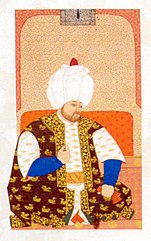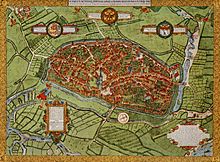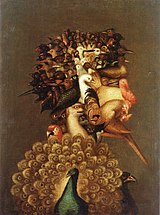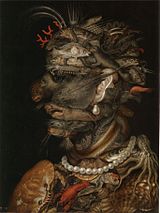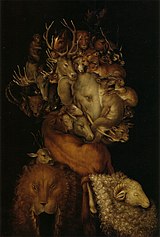1566
Portal history | Portal Biographies | Current events | Annual calendar
◄ |
15th century |
16th century
| 17th century
| ►
◄ |
1530s |
1540s |
1550s |
1560s
| 1570s
| 1580s
| 1590s
| ►
◄◄ |
◄ |
1562 |
1563 |
1564 |
1565 |
1566
| 1567
| 1568
| 1569
| 1570
| ►
|►►
| 1566 | |
|---|---|
|
Both Sultan Suleyman I and Nikola Šubić Zrinski perish during the siege of Szigetvár .
|
|
|
Selim II becomes Sultan of the Ottoman Empire . |
Giuseppe Arcimboldo paints, among other things, the picture The Jurist . |
| 1566 in other calendars | |
| Armenian calendar | 1014/15 (turn of the year July) |
| Ethiopian calendar | 1558/59 |
| Buddhist calendar | 2109/10 (southern Buddhism); 2108/09 (alternative calculation according to Buddha's Parinirvana ) |
| Chinese calendar | 71st (72nd) cycle
Year of the fire tiger丙寅 ( at the beginning of the year wood buffalo 乙丑) |
| Chula Sakarat (Siam, Myanmar) / Dai calendar (Vietnam) | 928/929 (turn of the year April) |
| Dangun era (Korea) | 3899/3900 (October 2/3) |
| Iranian calendar | 944/945 |
| Islamic calendar | 973/974 (turn of the year 18/19 July) |
| Jewish calendar | 5326/27 (September 13-14) |
| Coptic calendar | 1282/83 |
| Malayalam calendar | 741/742 |
| Seleucid era | Babylon: 1876/77 (turn of the year April)
Syria: 1877/78 (turn of the year October) |
| Vikram Sambat (Nepalese Calendar) | 1622/23 (turn of the year April) |
Events
Politics and world events
Eighty Years War
- April 5: A petition from the Dutch nobility to Margaret of Parma to mitigate the religious edicts and repeal the Inquisition and end the persecution of Protestants as well as the restoration of their class freedoms ( Nobility Compross of Breda ) is largely accepted by the Spanish governor with the promise, to forward the edict to King Philip of Spain . At the handover, Count Charles de Berlaymont allegedly whispers in Margarethe of Parma's ear, “She shouldn't be afraid of a bunch of beggars (gueux)”. At this point in time, this group consisted of two hundred mounted men who peacefully entered Brussels to hand over the petition. During a subsequent festival of the supplicants, Heinrich von Brederode proposed the designation Geusen for the members allied in the struggle for freedom and adopted it by those gathered. Also present are William I of Orange and Count Lamoral von Egmond and Philippe de Montmorency, Count von Horn . As a visible sign of the Confederation, the members wear gray beggar's robes while they are in Brussels.
- August 10: Protestants destroy religious images in a chapel in Steenvoorde as the prelude to the Dutch War of Independence . The example will be followed by further campaigns in Catholic churches in Flanders until October .
Holy Roman Empire
- May 10: The accused Bavarian aristocrats of the so-called Ortenburg aristocratic conspiracy are acquitted of their indictment at the Reichstag in Augsburg after signing a declaration .
- December 24: After the imperial ban against the Ernestine Duke . Johann Friedrich II has been pronounced, Elector starts August of Saxony at the head of an army of 5,489 horsemen and 31 infantry troop the siege of the Duke of Saxony residence Gotha .
- At the Reichstag in Augsburg , Emperor Maximilian II (HRR) did not find a majority in favor of expelling Calvinism from Germany , which was especially honored in the Palatinate . The assembly adopts the “Augsburg Imperial Coin Order ”, which brings stability to the monetary system for a long time .
Ottoman Empire
- Genoa loses the Greek island of Chios to the Ottomans .
- The siege of Szigetvár by the troops of the Ottoman Empire lasts from August 6th to September 8th and ends after a tough battle with the Turkish occupation of the castle. Sultan Suleyman the Magnificent dies during the siege . After his death, Selim II (called Mest "the drunk") becomes Sultan of the Ottoman Empire .
Southern Europe
- March 28th: Six months after the end of the siege of Malta by the Ottomans , Jean de la Valette , Grand Master of the Order of Malta , lays the foundation stone for the fortress town of Valetta , located behind Fort St Elmo . The plans for the geometric layout of the fortification walls and the right-angled road network were made by the Italian architect and fortress builder Francesco Laparelli . The design and completion of the individual fortress elements are largely left to the Maltese assistant Laparellis, Gerolamo Cassar .
Scotland
- February 24: James Hepburn, 4th Earl of Bothwell , favorite of the Scottish Queen Mary Queen of Scots , marries Jean Gordon, daughter of the former insurgent George Gordon, 4th Earl of Huntly , at her express behest .
- March 9: A group of Scottish aristocrats enter the private apartments of Mary Queen of Scots in Holyrood Palace and kill her private secretary and favorite David Rizzio in front of the pregnant Queen . The Italian-born Catholic has drawn the hatred of the Protestant nobility by increasingly gaining the queen's trust. The murderer is led by Mary's husband, Henry Stuart, Lord Darnley , whom the assassins were able to convince that Rizzio was Mary's lover. Maria Stuart is placed under house arrest. A little later, however, she is freed by her fickle husband and the two flee to Dunbar .
- June 19: Mary Queen of Scots gives birth to her son James at Edinburgh Castle . A little later, Lord Darnley flees to Glasgow when rumors of murder arise against him, but soon returns to Edinburgh at the request of his wife.
- December: Several Scottish nobles, including James Hepburn, 4th Earl of Bothwell , George Gordon, 5th Earl of Huntly , James Douglas, 4th Earl of Morton , and Secretary of State William Maitland , meet at Craigmillar Castle , a family castle Douglas in Edinburgh, and sign the Craigmillar bond , which seals the planned assassination of Mary Stuart's husband, Henry Stuart, Lord Darnley .
science and technology
- MARCH 25: John Corputius publishes the eponymous plan of the city of Duisburg from the air.
- Noe Meurer publishes his Practica of deß Cammer Rechts -ordnung vnd Proceß , the first systematic presentation of the process before the Reich Chamber Court .
Culture
Jacopo Tintoretto
The Venetian painter Jacopo Tintoretto completes the work The Crucifixion in oil on canvas . The painting, for which Tintoretto was paid 250 ducats on March 9, immediately became famous. It forms the climax of a passion cycle, which also includes the paintings Christ before Pilate , The Crowning of Thorns and The Walk to the Calvary .
Giuseppe Arcimboldo
The Renaissance painter Giuseppe Arcimboldo , court painter to Emperor Maximilian II in Vienna, produced the painting The Jurist in oil on canvas , which possibly depicts Johannes Calvin , but more likely Johann Ulrich Zasius , who was in charge of the imperial court finances at the time.
Arcimboldo also produced the Four Elements series of paintings for Emperor Maximilian II . Like Der Jurist , they are so-called composite heads: Each head is made up of objects or animals typical for the respective element : birds for air, torches, candles, cannons, etc. for fire, mammals for earth and marine animals for water. The pictures are shown as bust pictures in profile, with two heads each looking to the right and left. The four pictures correspond to the pictures of the four seasons from 1563 .
Pieter Bruegel
The Dutch Renaissance painter Pieter Bruegel the Elder paints the painting The Sermon of John the Baptist in oil on oak . The picture after a scene from the Gospels according to Matthew and Luke shows the sermon of John the Baptist , who just refers to his successor Jesus .
Another oil painting by Bruegel this year is The Bethlehem Census . The artist relocates the biblical events to a wintry Flemish village.
religion

- January 7th: The Conclave elects Grand Inquisitor Antonio Michele Ghislieri to succeed Pius IV, who died at the end of the previous year, as Pope . He takes the name Pius V on. His exemplary way of life, his modesty and simplicity, but also his zeal and inclination to be interested in all people's concerns, together with his reforms not only affecting the church, soon earned him the worship of the people, initially through elections a representative of the Inquisition who is considered to be relentless is appalled.
- October 18: Ernst of Bavaria is not yet twelve years old and is elected Bishop of Freising . Pope Pius V agrees that the descendant from the House of Wittelsbach should take office .
- Construction work on the new church of Santa Maria in Traspontina in Rome begins. The old church was closed in 1564 due to the expansion of the fortifications of the Castel Sant'Angelo . The church was not completed until 1668.

- August: In the Netherlands, so-called fence sermons ( hedge sermons ) lead to an iconoclasm by radical Calvinists lasting several days , during which more than 400 churches are devastated.
Disasters
- July 19: After a battle with the Swedes, the Luebian warship Morian and Admiral Bartholomeus Tinnappel as well as twelve other Danish and Lübeck ships sank off Gotland in a storm in which the anchors did not hold. After this accident, the Hanseatic city's fleet was only partially operational in the three-crown war .
- July: Rhine and Lake Constance floods of 1566 : numerous cities on Lake Constance , the Upper Rhine and the Upper Rhine are flooded by floods .
Historical maps and views
Born
Date of birth saved
- January 13: Maria von Braunschweig-Wolfenbüttel , Duchess of Saxony-Lauenburg († 1626)
- February 1: Barbe Acarie , French Carmelite († 1618)
- February 6: Georg Wecker , was a German medic and physicist († 1633)
- February 18: Francesco Erizzo , 98th Doge of Venice († 1646)
- February 23: Theodor Adamius , German lawyer and university professor († 1613)
- March 8: Carlo Gesualdo , Italian prince and composer († 1613)
- April 2: Maria Magdalena von Pazzi , Florentine Carmelite, mystic and saint of the Catholic Church († 1607)
- April 28: Joachim Zehner , clergyman and superintendent in Schleusingen († 1612)
- May 26th: Mehmed III. , Sultan of the Ottoman Empire († 1603)
- June 19: James I , King of England, as James VI. also King of Scotland († 1625)
- June 20: Sigismund III. Wasa , King of Poland and Titular King of Sweden († 1632)
- July 1: Bartholomäus Anhorn , Swiss pastor and historian († 1642)
- July 9: Johann Ernst , Duke of Saxony-Eisenach († 1638)
- August 12: Isabella Clara Eugenia , Spanish infanta and governor of the Spanish Netherlands († 1633)
- September 27: Daniel Colonius the Elder , Dutch Reformed theologian († 1635)
- October 28: Burkhard von Erlach , lawyer and court marshal († 1640)
- November 3: Charles de Bourbon , Count of Soissons and Viceroy of New France († 1612)
- November 6: Julien Perrichon , French lutenist and composer († around 1600)
- December 1: Philipp von Nassau , Dutch military († 1595)
- December 27: Jan Jessenius , physician, politician and philosopher of Slovak descent († 1621)
- December 30th: Alessandro Piccinini , Italian lutenist, theorbian player and composer († around 1638)
Exact date of birth unknown
- John Budden , English lawyer († 1620)
- Pjetër Budi , Albanian bishop of the diocese of Sapa and Sarda († 1622)
- Polyxena von Lobkowicz , Bohemian-Moravian nobleman († 1642)
Born around 1566
- William Brewster , Church Elder of the Separatist Congregationalists on board the Mayflower († 1644)
Died
Date of death secured
- January 3: Philip II of Nassau-Idstein , regent of Nassau-Wiesbaden-Idstein (* 1516)
- January 6th: Francesco II Gonzaga , Cardinal of the Roman Catholic Church (* 1538)
- March 9: David Rizzio , Italian musician, private secretary and favorite of Maria Stuart (* around 1533)
- March 23: Wolfgang , Prince of Anhalt-Köthen and reformer (* 1492)
- March 28: Siegmund von Herberstein , Austrian imperial councilor and envoy to the Russian court (* 1486)
- April 4: Daniele da Volterra , Italian painter and sculptor (* 1509)
- April 18: Johann Draconites , German theologian, humanistic philosopher and reformer (* 1494)
- April 22nd: Diana of Poitiers , Countess of Saint-Vallier, Duchess of Étampes and Duchess of Valentinois, mistress of Henry II of France (* 1499)
- April 25: Louise Labé , French poet (* around 1524)
- May 10: Leonhart Fuchs , German botanist and physician (* 1501)
- May 26: Antonio de Cabezón , Spanish composer and organist (* 1510)
- June 4th: Matthaeus Collinus , Bohemian teacher and writer (* 1516)
- July 2: Nostradamus , French pharmacist, self-proclaimed doctor and "star friend", author of prophecies (* 1503)
- July 6th: Margarethe von der Saale , second wife of Landgrave Philip I of Hesse (* 1522)
- July 18: Bartolomé de Las Casas , Dominican and lawyer in the Spanish colonies in America (* 1484)
- 4th August: Christoph von Oldenburg , Count of Oldenburg, general (* 1504)
- August 4th: Girolamo della Robbia , Italian sculptor and architect (* 1488)
- September 6th: Ambrosius Schlumpf , Swiss politician and mayor of St. Gallen (* 1497)

- September 6: Suleyman I , Sultan of the Ottoman Empire (* 1495)
- September 8: Nikola Šubić Zrinski , Ban of Croatia, imperial general and hero of the siege of Szigetvár (* 1508/18)
- September 17: Hieronymus Tilesius , German Lutheran theologian and reformer (* 1529)
- September 22nd: Johannes Agricola , German reformer (* 1494)
- October 10: Tiberio Crispo , Cardinal Bishop of Sabina (* 1498)
- October 17th: Paul Neefe , cloth merchant, mayor of Chemnitz (* 1507)
- October 29: Jacobus de Dacia , Danish Franciscan and missionary in Mexico (* around 1484)
- November 17th: Raffaellino del Colle , Italian painter (* 1490)
- November 27th: Froben Christoph von Zimmer , Swabian nobleman and chronicler (* 1519)
- November 29: Nikolaus Gromann , court architect in the service of the Ernestine Wettins (* around 1500)
- December 19: Luis Hurtado de Mendoza y Pacheco , Viceroy of Navarre, Chairman of the Council of India and the Council of Castile (* 1489)
Died around 1566
- John Halle , English surgeon, poet and author of medical treatises (* around 1529)

